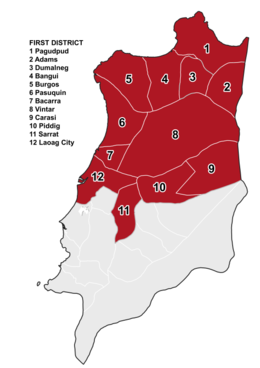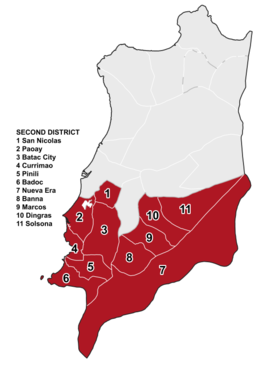The legislative districts of Ilocos Norte are the representations of the province of Ilocos Norte in the various national legislatures of the Philippines. The province is currently represented in the lower house of the Congress of the Philippines through its first and second congressional districts.
The first and second districts of Ilocos Norte are among the original representative districts from 1907 which has never changed in territorial coverage, along with the first districts of Albay, of Ilocos Sur and of Iloilo.
History
The province has been divided into two districts since 1907. When seats for the upper house of the Philippine Legislature were elected from territory-based districts between 1916 and 1935, the province formed part of the first senatorial district which elected two out of the 24-member senate.
In the disruption caused by the Second World War, two delegates represented the province in the National Assembly of the Japanese-sponsored Second Philippine Republic: one was the provincial governor (an ex officio member), while the other was elected through a provincial assembly of KALIBAPI members during the Japanese occupation of the Philippines. Upon the restoration of the Philippine Commonwealth in 1945, the province continued to comprise two representative districts.
Ilocos Norte was represented in the Interim Batasang Pambansa as part of Region I from 1978 to 1984, and returned two representatives, elected at-large to the Regular Batasang Pambansa from 1984 to 1986. The province retained its two congressional districts under the new Constitution which was proclaimed on February 11, 1987, and elected members to the restored House of Representatives starting that same year.
1st District

- City: Laoag (became city 1965)
- Municipalities: Bacarra, Bangui, Pasuquin, Piddig, Sarrat (San Miguel), Vintar (re-established 1909), Burgos (Nagparitan) (re-established 1913), Pagudpud (established 1959), Adams (established 1983), Carasi (established 1983), Dumalneg (established 1983)
- Population (2020): 311,977
Notes
- Relinquished seat in 1955 after winning election for governor of Ilocos Norte.
- Resigned seat following appointment as Secretary of Public Works on August 24, 1966.
- Won special election held on November 14, 1967 to fill vacated seat; took oath of office on January 22, 1968 and served for the remainder of the 6th Congress.
2nd District

- City: Batac (became city 2007)
- Municipalities: Badoc, Dingras, Paoay, San Nicolas (re-established 1909), Solsona (re-established 1909), Banna (Espiritu) (established 1913), Nueva Era (established 1919), Pinili (established 1919), Currimao (established 1920), Marcos (established 1963)
- Population (2020): 297,611
Notes
- Assassinated on September 20, 1935, before taking second term in office.
- Assumed office after winning the special election held on July 22, 1936 to fill vacant seat.
- Elected in 1959 to the Senate; seat remained vacant until the end of the 4th Congress.
At-Large (defunct)
| Period | Representatives |
|---|---|
| National Assembly 1943–1944 |
Conrado Rubio |
| Emilio L. Medina (ex officio) | |
| Regular Batasang Pambansa 1984–1986 |
Maria Imelda R. Marcos |
| Antonio V. Raquiza |
References
- 1986 Constitutional Commission (February 2, 1987). "1987 Constitution of the Philippines - Apportionment Ordinance". Retrieved June 13, 2016.
{{cite web}}: CS1 maint: numeric names: authors list (link) - ^ Congressional Library Bureau. "Roster of Philippine Legislators". Republic of the Philippines, House of Representatives. Retrieved February 17, 2017.
- ^ Official program of the inauguration of the Republic of the Philippines and the induction into office of His Excellency Jose P. Laurel. Bureau of Printing. 1943.

